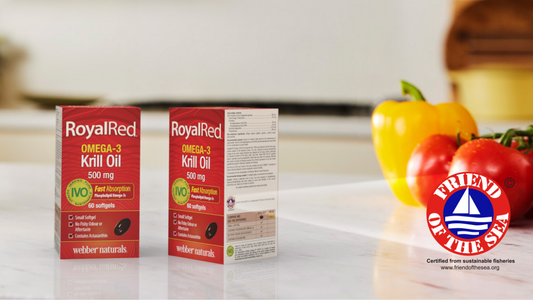The Ultimate Guide to Omegas and Fatty Acids

Omega-3 and omega-6 fatty acids are specific types of essential fatty acids (EFAs) that play crucial roles in your overall health throughout life.
The word “fat” usually depicts a negative connotation, but omega-3 and omega-6 fats are anything but negative. When consumed in the right proportions, these healthy fats help nourish your body and deliver many health benefits.
In this Ultimate Guide to Omegas and Fatty Acids, you’ll learn more about the importance of including EFAs in your diet, the different types of omega fats and their key health benefits, and important considerations when choosing an omega supplement.
Table of Contents
- Why We All Need Essential Fatty Acids
- Getting to know your omegas!
- What Are EPA and DHA?
- What Are LA, GLA,and OA?
- How to Choose an Omega Supplement
- Omega-3 Comparison Table
Why We All Need Essential Fatty Acids
EFAs are essential! As the body cannot make EFAs, we need to get them through our diet or supplementation. EFAs, which include omega-3 and omega-6 fatty acids, are vital for all stages of life, beginning with fetal brain development through to our senior years, preserving cognitive function. [1][2]
Key Health Benefits of Omega-3s
Omega-3 EFAs are important for overall good health from infancy to adulthood. In summary, omega-3s support:
- Brain health – Support brain function and cognitive health [3]
- Heart health – Help maintain cardiovascular health and reduced serum triglycerides (a type of fat, or lipid, found in the blood) [3]
- Prenatal and children’s health – Help support the development of the brain, eyes, and nerves in children up to 12 years of age [3]
- Healthy levels of anti-inflammatory activity in the body – Help reduce the pain of rheumatoid arthritis in adults when used alongside conventional therapies [1][2][3]
Key health benefits of omega-6s
Omega-6 EFAs are essential for good health, supporting the structure and function of cell membranes and helping balance anti-inflammatory activities in the body. [1] It is important to note that while omega-6 fatty acids are essential, maintaining a balanced intake of omega-6 and omega-3 fatty acids is key to their success.
Getting to Know Your Omegas!
The typical Western diet tends to be high in meat and refined vegetable oils that provide an excess of omega-6s and too few omega-3s. This diet results in an imbalanced omega-3/6 fatty acid ratio in the body, which is estimated to range from 5–15 parts omega-6 to 1 part omega-3. This ratio is significantly different from the 1:1–2:1 ratio found in the human diet in the past. [1][4] Overeating omega-6 fatty acids paired with a low intake of omega-3 fatty acids is associated with multiple modern-day health problems that impact the optimal health of our skin, eyes, and brain function. [1][2]
An imbalanced omega-3 to omega-6 intake can be corrected by consuming food or supplements that contain the long-chain omega-3s eicosatetraenoic acid (EPA) and docosahexaenoic acid (DHA), or the short-chain omega-3 alpha-linolenic acid (ALA), which the body converts into limited amounts of EPA and DHA.
What are EPA and DHA?
EPA and DHA are long-chain polyunsaturated fatty acids (PUFAs) and key members of the omega-3 family of EFAs that the body needs for optimal health. They help regulate triglycerides and blood pressure, keep brain and nerve cells healthy for memory and learning support, and relieve certain types of arthritis. DHA is especially important and abundant in the central nervous system and eyes. [1][3]
What is alpha-linolenic acid (ALA)?
Most plant-based omega-3s are in the form of a shorter-chain omega-3 called ALA, which is converted in the body to make EPA and limited amounts of DHA. ALA supports many aspects of health, both on its own and through its conversion to EPA, working as an anti-inflammatory and neuroprotective nutrient. [1] Because the conversion of ALA to EPA and DHA is inefficient, it is important to include direct sources of EPA and DHA, along with ALA, in the diet.
Omega-3 food sources
ALA is the most common source of omega-3 in Western diets and is found in numerous plant-based foods, such as: [1][4]
- Walnuts
- Flax seeds/oil
- Chia seeds
- Pumpkin seeds/oil
- Some green leafy vegetables
Direct sources of the omega-3s EPA and DHA include: [5][6]
- Microalgae and their oil
- Krill fish/oil
- Cold-water fish/fish oils, including salmon, sardines, and mackerel
What are LA, GLA, and OA?
In addition to omega-3s, PUFAs are grouped into the omega-6 and omega-9 families of fatty acids, each with their own important roles in the body.
Omega-6 linoleic acid (LA)
LA is an omega-6 polyunsaturated fatty acid. The body relies on LA for the synthesis of other omega-6 fatty acids, including gamma-linolenic acid (GLA), dihomo-γ-linolenic acid (DGLA), and arachidonic acid (AA). [1]
Omega-6 gamma-linolenic acid (GLA)
GLA is produced in the body from LA and can be consumed directly from certain plant-based oils, such as evening primrose oil and borage oil. Most GLA is rapidly converted by the body to DGLA, leading to a wide range of anti-inflammatory functions. [1]
Omega-9 oleic acid (OA)
Omega-9 fatty acids can be made by the body and are therefore not considered essential. However, studies have demonstrated additional benefits from consuming a diet rich in plant-based OA. Thanks to its anti-inflammatory and vascular activities in the body, OA is one of the reasons why the Mediterranean diet is considered so healthy. [7]
Omega-6 and omega-9 food sources
Omega-6 fatty acids are found in many of the common vegetable oils used for cooking, such as: [1][2]
- Corn
- Safflower
- Sunflower
- Soybean oils
Other healthy sources of omega-6s include: [1][2]
- Pumpkin seeds
- Walnuts
- Evening primrose oil
- Borage oils
- Meat from grain-fed livestock
Wonderful sources of omega-9 fatty acids include monounsaturated fat found in: [8]
- Olive oil
- Nuts
- Sunflower seeds
- Olives
- Avocados
Maximizing your PUFA intake
EFAs are vulnerable to degradation. Omega-3s and omega-6s found in refined cooking oils or processed foods are especially prone to damage by light, heat, and exposure to oxygen in the air. Consuming EFAs from fresh wholefoods, cold-pressed oils like olive oil, and high-quality supplements can help maximize their nutritional benefits. [9][10]
How to Choose an Omega Supplement
1. Make Sure Your Omega-3 is an Eco-Friendly Omega
How do you know you are buying a high-quality, eco-friendly omega supplement? Look for third-party certifications like International Verified Omega-3™ (IVO™). This guarantees that the fish oils used are of the highest quality, in addition to being sustainably harvested.
IVO is a marine oil testing and certification program that adheres to the world’s highest standards for purity and potency verification. To obtain the IVO seal, products must pass a comprehensive set of quality checks, including tests for as many as 500+ potential contaminants.
IVO advocates for sustainability by ensuring that fish oils are sourced from wild-caught and responsibly managed harvests, ensuring that no endangered species are put at further risk.
Webber Naturals omega-3 fish oils are IVO-certified, so you can feel confident in choosing the right omega-3 for you and your family.
Click here to learn more about IVO.

2. Choose clear enteric softgels
Fish burps are the result of fish oil beginning to digest in the stomach. For some people, the discomfort of fish burps leads to avoiding omega-3 supplements altogether. Thankfully, we have a solution!
Our clear enteric softgel technology enables the softgel to bypass the stomach completely and go straight to the intestine where it is digested and absorbed, thereby preventing fishy burps.
What does “clear enteric” mean?

Our omega-3 clear enteric softgels build natural enteric ingredients right into the softgels themselves, rather than spraying a coating on the outside.
As mentioned, this technology allows softgels to pass through the stomach and into the lower gastrointestinal tract unharmed, without the risk of flaking, peeling, or cracking that sometimes causes external enteric coatings to fail.
The difference is clear. Our unique clear enteric technology guarantees no fishy aftertaste!
Comparison Chart of Omega Supplements
If you want the omega-3 benefits of fish without eating fish, Webber Naturals offers a range of high-quality and sustainably sourced omega-3 supplements to complement a healthy diet.
Take a look at the full line of Webber Naturals omegas and fatty acids to help you maintain good health.

References :
2. Mariamenatu AH, Abdu EM. Overconsumption of omega-6 polyunsaturated fatty acids (PUFAs) versus deficiency of omega-3 PUFAs in modern-day diets: The disturbing factor for their “balanced antagonistic metabolic functions” in the human body. J Lipids. 2021; 2021:8848161.
3. Health Canada. Monograph: Fish oil. 2018. Available from: https://webprod.hc-sc.gc.ca/nhpid-bdipsn/monoReq.do?id=88&lang=eng
4. Simopoulos AP. The omega-6/omega-3 fatty acid ratio: Health implications. 2010; 17(5):267-75.
5. Saini RK, Prasad P, Sreedhar RV, et al. Omega-3 polyunsaturated fatty acids (PUFAs): Emerging plant and microbial sources, oxidative stability, bioavailability, and health benefits-A review. Antioxidants (Basel). 2021; 10(10):1627.
6. Yurko-Mauro K, Kralovec J, Bailey-Hall E, et al. Similar eicosapentaenoic acid and docosahexaenoic acid plasma levels achieved with fish oil or krill oil in a randomized double-blind four-week bioavailability study. Lipids in Health Dis. 2015; 14:99.
7. Sakurai K, Shen C, Shiraishi I, et al. Consumption of oleic acid on the preservation of cognitive functions in Japanese elderly individuals. Nutrients. 2021; 13(2):284.
8. Farag MA, Gad MZ. Omega-9 fatty acids: Potential roles in inflammation and cancer management. J Genet Eng Biotechnol. 2022; 20(1):48.
9. Yenipazar H, Şahin-Yeşilçubuk N. Effect of packaging and encapsulation on the oxidative and sensory stability of omega-3 supplements. Food Sci Nutr. 2022; 11(3):1426-40.
10. Nogueira MS, Scolaro B, Milne GL, et al. Oxidation products from omega-3 and omega-6 fatty acids during a simulated shelf life of edible oils. LWT. 2019; 101:113-22.
11. Langlois K, Ratnayake WM. Omega-3 index of Canadian adults. Health Rep. 2015; 26(11):3-11.
 Free returns & exchanges
Free returns & exchanges



